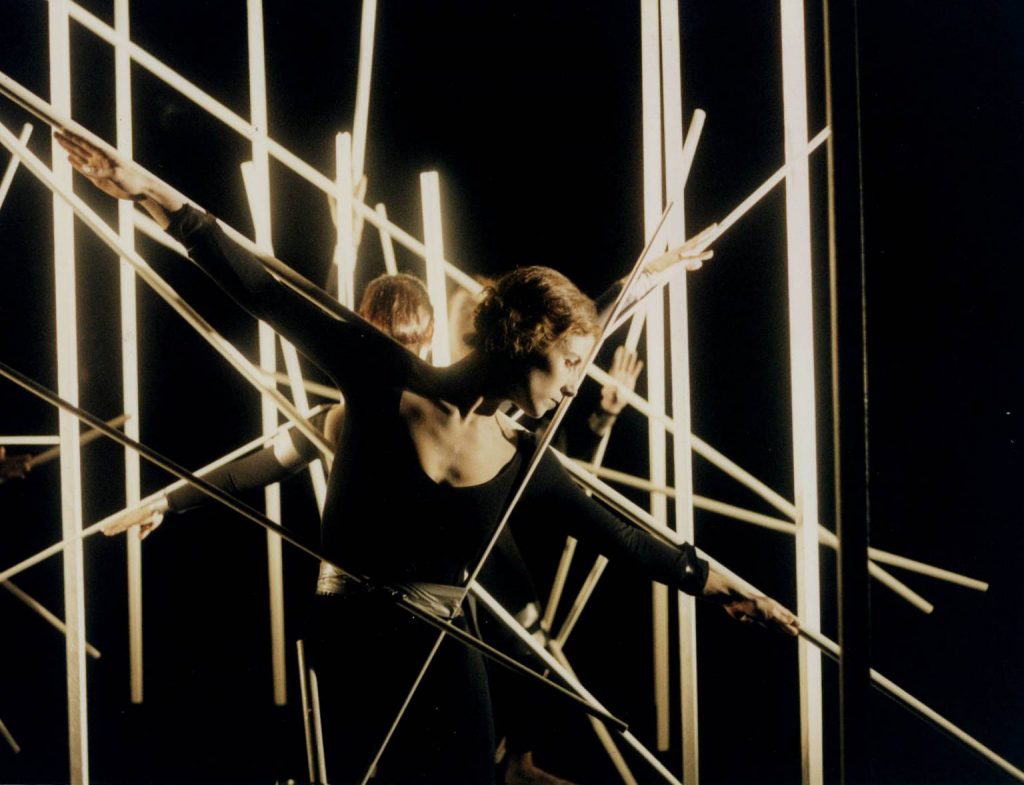Artist:
Daria Martin (born 1973 in San Francisco, USA; lives and works in London, England).
Materials:
16-mm film, projection, color, and sound; 7 min.
Description:
“In the Palace began with a daydream to enter inside two inaccessible places, to penetrate the tinyness of [Alberto] Giacometti’s surrealist sculpture The Palace at 4am (1932) and to move beyond the flatness of various photographs of early Modern stage and dance productions. In this film, Giacometti’s sculpture (which in a sense already resembles a theatrical model) is streamlined and scaled up to become a stage set proper; the posed theatrical stills are restaged as tableaux vivants.—”In the Palace,” website of Daria Martin.
“In the Palace is the first film in a trilogy followed by Birds (2001) and Closeup Gallery (2003) . It constituted Daria Martin’s MFA thesis at University of California, Los Angeles and was shot with a 16-mm camera and released in an edition of four… The film is set in a scaled up twenty-five foot (7620 mm) high version of the sculpture The Palace at 4 A.M. (1932) (Museum of Modern Art, New York) by Swiss artist Alberto Giacometti (1901–66), from which it takes its title. Giacometti’s sculpture is a fragile structure made of wood, glass, wire and string, and is open and accessible on all sides. When seen from the front it appears to be divided into three cages, inhabited by isolated forms and figures. Martin first saw Giacometti’s sculpture in her visits to the Museum of Modern Art in New York during her student years, and became attracted to the work’s ‘particularly evocative feeling, as if the figures within it have each been caught within their own dreams, simultaneously sleepwalking through the same house’ (quoted in Daria Martin, p.76). The artist measured the sculpture in MoMA’s archive for the correct proportions, and built the stage herself with the assistance of her art school friends. ‘The idea that sparked In the Palace’ Martin has explained, ‘was a desire to literally realize my own fantasy to inhabit this small sculpture, to blow it up to human dimensions and to populate it with performers’ (quoted in ibid., p.76).
“In the film, the camera ceaselessly circles around a group of four performers standing inside this cage-like space, a white painted wooden construction that resembles a scaffold structure. Spotlit against a darkened background, the performers hold sequences of classical poses that resemble the forms of early twentieth century dance productions, in particular the choreographies of the Ballet Russes from the 1910s and 1920s, the dramatic atmosphere of Lamentation (1930) by American dancer Martha Graham (1894–1991), and most notably, the Slat Dance 1927 conceived by German artist Oskar Schlemmer (1888–1943). Accompanied by a soundtrack of rainfall, thunder, and birds singing, each shot shows the transformation of the performers by the introduction of a new set of handmade costumes constructed from diverse materials including cardboard, aluminium paper foil and elastic fabrics, and the addition of props, such as hoops or canes. These sequences of extended shots are edited together and seem to comprise a single relentless circular motion around the performers, only occasionally punctured when they break their poses before the end of each shot.”
—Carmen Juliá, “Daria Martin: In the Palace; 2000,” Tate, last modified April 2009.
“I was also attracted to the sense of freedom that this return to “modernism” seemed to promise, but I worried that what many artists were doing wilfully shut out the whole arena of the body and its vulnerability.”—Daria Martin, in Daria Martin, p.75


